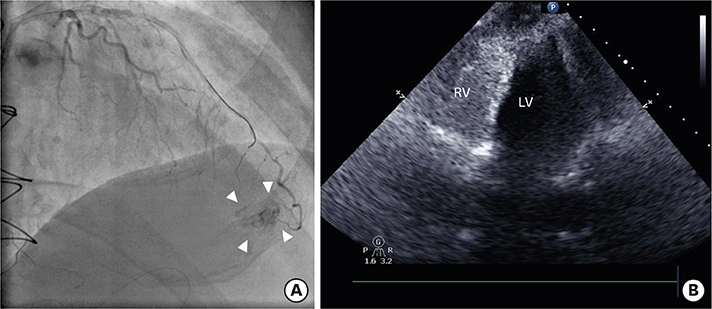Korean Circ J.
2018 Nov;48(11):1028-1029. 10.4070/kcj.2018.0179.
Defining Coronary Artery Perforation with Ultrasound Contrast Agent
- Affiliations
-
- 1Division of Cardiology, Department of Internal Medicine, Wonju College of Medicine, Yonsei University, Wonju, Korea.
- 2Division of Cardiovascular Medicine, Calhoun Cardiovascular Center, University of Connecticut School of Medicine, Farmington, CT, USA. azrin@uchc.edu
- KMID: 2422552
- DOI: http://doi.org/10.4070/kcj.2018.0179
Abstract
- No abstract available.
MeSH Terms
Figure
Reference
-
1. Ellis SG, Ajluni S, Arnold AZ, et al. Increased coronary perforation in the new device era. Incidence, classification, management, and outcome. Circulation. 1994; 90:2725–2730.
Article2. Oreglia JA, Bruschi G, Klugmann S. Percutaneous treatment of iatrogenic left-anterior descending artery to right ventricle fistula. Catheter Cardiovasc Interv. 2010; 76:975–977.
Article3. Main ML, Hibberd MG, Ryan A, Lowe TJ, Miller P, Bhat G. Acute mortality in critically ill patients undergoing echocardiography with or without an ultrasound contrast agent. JACC Cardiovasc Imaging. 2014; 7:40–48.
Article4. Muskula PR, Main ML. Safety with echocardiographic contrast agents. Circ Cardiovasc Imaging. 2017; 10:e005459.
Article
- Full Text Links
- Actions
-
Cited
- CITED
-
- Close
- Share
- Similar articles
-
- Contrast Echo-A Simple Diagnostic Tool for a Coronary Artery Fistula
- Prevention of Coronary Artery Perforation and Its Treatment During CTO PCI: Study of Effective Coiling for Distal and Collateral Perforations
- A Case of Right Coronary Artery Hematoma Detected by Echocardiography after Percutaneous Coronary Intervention
- Guidewire-Induced Perforation of Distal Circumflex Artery Treated with Transcatheter Embolization of Polyvinyl Alcohol Form
- Simple Management of Radial Artery Perforation during Transradial Percutaneous Coronary Intervention


